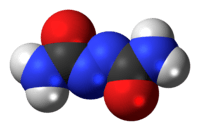Azodicarbonamide
 | |
 | |
| Names | |
|---|---|
| IUPAC name
Carbamoyliminourea | |
| Other names
Azodicarboxamide; Azobisformamide; C,C'-Azodi(formamide); Diazenedicarboxamide | |
| Identifiers | |
| 123-77-3 | |
| 3D model (Jmol) | Interactive image |
| ChEMBL | ChEMBL28517 |
| ChemSpider | 4575589 |
| ECHA InfoCard | 100.004.229 |
| EC Number | 204-650-8 |
| E number | E927a (glazing agents, ...) |
| PubChem | 31269 |
| UNII | 56Z28B9C8O |
| |
| |
| Properties | |
| C2H4N4O2 | |
| Molar mass | 116.08 g·mol−1 |
| Appearance | Yellow to orange/red crystalline powder |
| Melting point | 225 °C (437 °F; 498 K) (decomposes) |
| Hazards | |
| Safety data sheet | |
| EU classification (DSD) |
Harmful (Xn) |
| R-phrases | R42 R44 |
| S-phrases | S22 S24 S37 |
| NFPA 704 | |
| Except where otherwise noted, data are given for materials in their standard state (at 25 °C [77 °F], 100 kPa). | |
| | |
| Infobox references | |
Azodicarbonamide, or azo(bis)formamide, is a chemical compound with the molecular formula C2H4O2N4.[1] It is a yellow to orange-red, odorless, crystalline powder.
Applications
Blowing agent
The principal use of azodicarbonamide is in the production of foamed plastics as a blowing agent. The thermal decomposition of azodicarbonamide results in the evolution of nitrogen, carbon monoxide, carbon dioxide, and ammonia gases, which are trapped in the polymer as bubbles to form a foamed article.
Azodicarbonamide is used in plastics, synthetic leather, and other industries and can be pure or modified. Modification affects the reaction temperatures. Pure azodicarbonamide generally reacts around 200 °C. In the plastic, leather, and other industries, modified azodicarbonamide (average decomposition temperature 170 °C) contains additives that accelerate the reaction or react at lower temperatures.
An example of the use of azodicarbonamide as a blowing agent is found in the manufacture of vinyl (PVC) foam, where it plays a role in the formation of air bubbles by breaking down into gas at high temperature. Vinyl foam is springy and does not slip on smooth surfaces. It is useful for carpet underlay and floor mats. Commercial yoga mats made of vinyl foam have been available since the 1980s; the first mats were cut from carpet underlay.[2]
Food additive
As a food additive, azodicarbonamide is used as a flour bleaching agent and a dough conditioner.[3] It reacts with moist flour as an oxidizing agent.[4] The main reaction product is biurea, a derivative of urea, which is stable during baking.[4] Secondary reaction products include semicarbazide and ethyl carbamate.[3] It is known by the E number E927. Many restaurants in the US fast food industry removed the additive in response to negative publicity.[5]
Safety and regulation
In the United States, azodicarbonamide has generally recognized as safe (GRAS) status and is allowed to be added to flour at levels up to 45 ppm.[6][7] Azodicarbonamide has not been authorized for use in Australia and the European Union as a food additive.[7][8]
Controversy over use in foods
In 2014, amid public discomfort with the dual uses of azodicarbonamide, the sandwich franchise Subway announced that it would no longer use it as a dough conditioner.[9]
Center for Science in the Public Interest stated azodicarbonamide "has been poorly tested" and advocates for reducing the amount of azodicarbonamide that is allowed to be used in food.[9]
Safety and regulation
Azodicarbonamide as a blowing agent in plastics has been banned in the European Union since August 2005 for the manufacture of plastic articles that are intended to come into direct contact with food.[10]
In the UK, the Health and Safety Executive has identified azodicarbonamide as a respiratory sensitizer (a possible cause of asthma) in workplace settings and determined that containers of it should be labeled with "May cause sensitisation by inhalation."[11] In a 1999 report, the World Health Organization linked azodicarbonamide to "respiratory issues, allergies and asthma" for individuals at workplaces where azodicarbonamide is manufactured or handled in raw form. The available data are restricted to these occupational environments. Exposure of the general public to azodicarbonamide could not be evaluated because of the lack of available data.[12] The WHO concluded, "The level of risk is uncertain; hence, exposure levels should be reduced as much as possible".
References
- ↑ "Azodicarbonamide (CICADS)". Inchem. International Programme on Chemical Safety. Archived from the original on 24 August 2010. Retrieved 2010-08-14. Also published by World Health Organization, Geneva, 1999.
- ↑ Friend, John (2009). History of Yoga Mat - Looking back with Friends.
- 1 2 FDA Frequently Asked Questions on Azodicarbonamide (ADA) Page Last Updated: 20 June, 2014
- 1 2 WHO FAO 1965. Toxicological Evaluation of Some Antimicrobials, Antioxidants, Emulsifiers, Stabilizers, Flour-Treatment Agents, Acids and Bases: Azodicarbonamide FAO Nutrition Meetings Report Series No. 40A,B,C. WHO/Food Add./67.29
- ↑ "The Yoga-Mat Chemical's Quiet Fast-Food Exit". Bloomberg. Retrieved 2016-08-08.
- ↑ "21CFR172.806". Code of Federal Regulations. April 1, 2012.
- 1 2 Smith, Jim; Hong-Shum, Lily (2011). Food additives data book (2nd ed.). Chichester, West Sussex: Wiley-Blackwell. p. 548. ISBN 978-1405195430.
- ↑ European Commission. "European Union: Authorisation of Additives". Retrieved 2014-12-31.
- 1 2 Landau, Elizabeth (February 17, 2014). "Subway to remove 'dough conditioner' chemical from bread". CNN. Retrieved 3 November 2015.
- ↑ "COMMISSION DIRECTIVE 2004/1/EC of 6 January 2004 amending Directive 2002/72/EC as regards the suspension of the use of azodicarbonamide as blowing agent". Official Journal of the European Union. 2004-01-13. Retrieved 2011-03-10.
- ↑ "Substances causing/worsening asthma". UK Occupational Health and Safety. WorkSafe Victoria. Archived from the original on May 31, 2013. Retrieved 2010-08-14.
- ↑ "Concise International Chemical Assessment Document 16: Azodicarbonamide" (PDF). World Health Organization. Retrieved 2014-02-05.
